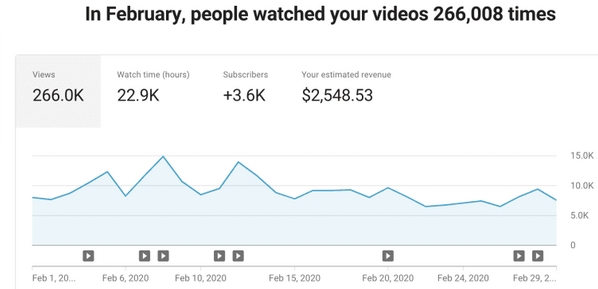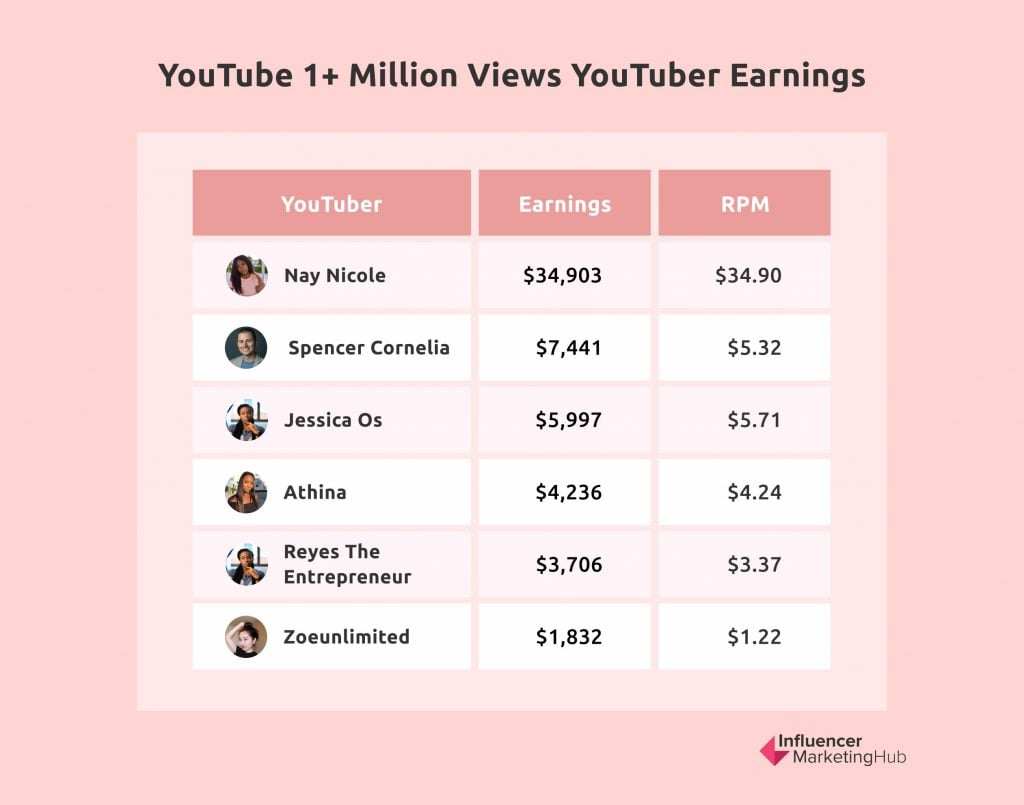YouTube has become a global platform where creators can showcase their talent, share knowledge, and entertain millions. With over 2 billion active users, it’s no surprise that some videos rack up impressive view counts, with tens of millions of views becoming a common milestone. But what does it really mean to earn from these views? In this post, we’ll dive into the fascinating world of YouTube earnings, particularly from an eye-popping 35 million views, and shed light on what factors come into play when it comes to monetization.
Factors Influencing YouTube Earnings

You might be wondering, “How do creators actually earn money on YouTube?” Well, YouTube earnings can vary significantly based on a variety of factors. Let’s break it down!
- Ad Revenue: The primary source of income for most creators comes from advertising. YouTube uses a system called CPM (Cost Per Mille), which pays per 1,000 views of monetized ads. The average CPM can range from $1 to $20, depending on many elements.
- Audience Demographics: The location and demographics of your audience can greatly affect earnings. Ads targeted at viewers in higher-income countries typically have a higher CPM compared to lower-income regions. For instance, views from viewers in the U.S. or Canada usually yield more revenue than those from other countries.
- Content Type: The type of content you produce also influences earnings. Certain niches, like finance and technology, tend to attract more lucrative ads compared to others, like lifestyle or entertainment. Advertisers are often willing to pay more for niches that align with their business goals.
- Engagement Rates: Higher engagement levels (likes, comments, shares) can lead to more ad impressions, which boosts earnings. Videos that foster a community and strong viewer interaction typically perform better financially.
- Seasonality: Earnings can fluctuate based on the time of year. For example, Q4 often brings in higher ad rates due to increased spending during the holiday season. Creators may experience spikes in revenue during these months.
By understanding these factors, creators can strategize better to maximize their earnings potential on YouTube! Each element plays a crucial role in determining how much a video with 35 million views can actually earn, making it essential for aspiring YouTubers to take notice.
Estimated Earnings Per Thousand Views

When it comes to understanding how much money can be made on YouTube, one crucial metric is the Estimated Earnings Per Thousand Views (often abbreviated as EPM or RPM). This figure gives creators a snapshot of their earnings based on their video views, and it can vary widely based on several factors.
Typically, the average YouTube creator can expect to earn anywhere from $1 to $5 per 1,000 views. However, this number can fluctuate based on:
- Content Type: Channels that create content in niche markets like finance or technology often earn more due to higher advertiser competition.
- Location: Viewers from different countries generate different ad rates. For example, audiences in the United States might lead to higher earnings than those in other countries.
- Engagement Levels: Videos that engage viewers (likes, comments, shares) can lead to better ad placements and increased earnings.
If we take the average RPM of $2, for 35 million views, the estimated earnings would be:
| RPM | Estimated Earnings |
|---|---|
| $1 | $35,000 |
| $2 | $70,000 |
| $5 | $175,000 |
Ultimately, understanding Estimated Earnings Per Thousand Views helps creators set realistic expectations and make informed decisions about their channel growth strategy.
Understanding YouTube Monetization Methods
YouTube offers several monetization methods that creators can leverage to make money from their content. Grasping these methods is vital for anyone looking to turn their channel into a revenue-generating platform. Here’s a breakdown of the most popular monetization methods available:
- Ad Revenue: This is the most common method. Creators will earn money through ads displayed on their videos. The amount can vary depending on various factors, including audience demographics and ad engagement.
- Channel Memberships: For creators with a loyal fanbase, channel memberships allow viewers to pay a monthly fee for special perks, such as exclusive content, badges, and emojis.
- Super Chat and Super Stickers: During live streams, fans can pay to have their messages highlighted, showing support for their favorite creators.
- Affiliate Marketing: By promoting products or services and including affiliate links in their video descriptions, creators can earn a commission on sales generated through their links.
- Sponsorships: Many brands look for collaboration opportunities with popular YouTubers. Creators can earn substantial income by promoting a product or service in their videos.
Different monetization methods can complement one another, allowing creators to diversify their income streams. Understanding these methods is not just beneficial—it's essential for maximizing earnings on the platform!
Real-Life Case Studies
When it comes to understanding how earnings on YouTube can vary from channel to channel, looking at real-life case studies can provide invaluable insights. Here, we explore three diverse channels that have achieved significant traction on the platform, showcasing different approaches and earnings in relation to their view counts.
1. Gaming Channel: PewDiePie
- Views: 110 million (example average monthly views)
- Estimated Earnings: $75,000 - $150,000 per month
- Revenue Sources: Ad revenue, sponsorships, merchandise
PewDiePie is a gaming legend and one of the most recognized creators on YouTube. His content ranges from gameplay to vlogs, which keeps his audience engaged. With a combination of high CPM rates and diversified income streams, he can maximize his earnings significantly.
2. Beauty Vlogger: Zoella
- Views: 30 million (example average monthly views)
- Estimated Earnings: $20,000 - $40,000 per month
- Revenue Sources: Ad revenue, beauty brand collaborations
Zoella has built a brand on beauty, fashion, and lifestyle content. Her niche helps her attract sponsorship deals and collabs that elevate her earning potential beyond traditional ad revenue, demonstrating the value of content specialization.
3. Education Channel: Crash Course
- Views: 10 million (example average monthly views)
- Estimated Earnings: $5,000 - $15,000 per month
- Revenue Sources: Ad revenue, Patreon support
Crash Course focuses on educational content. Their engaging videos encourage viewers to support them through platforms like Patreon, showing that educational channels can foster community support that complements ad earnings.
Conclusion
So, what have we learned from the case studies above? It’s clear that YouTube earnings can vary dramatically depending on several factors, including niche, audience engagement, and additional revenue streams. While 35 million views might paint a picture of wealth, the reality is multifaceted.
Here’s a quick recap of the key takeaways:
- Niche Matters: Different niches attract different levels of viewer engagement and advertising rates. For instance, tech channels might see higher CPMs than lifestyle ones.
- Diverse Income Streams: Creators who diversify their income—through sponsorships, merchandise, or fan support—often see greater overall earnings.
- Viewer Engagement: Channels that connect with their audience are likely to retain viewers and increase earnings through loyalty and community support.
Ultimately, while 35 million views can lead to impressive earnings, it’s only part of the equation. The dedication, strategy, and niche can significantly influence a creator’s financial success on YouTube. The platform remains a powerful avenue for aspiring creators, but understanding these dynamics is crucial for those looking to turn their passion into profit.










